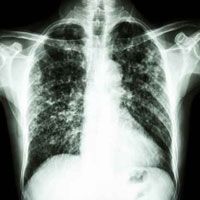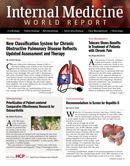Low Dose Computed Tomography Scanning for Patients at risk for Lung Cancer
The leading cause of cancer related deaths in both men and women is lung cancer. The 5-year survival rate of lung cancer is only 16%, as 75% of patients with lung cancer are presented with symptoms of advanced disease.

The leading cause of cancer related deaths in both men and women is lung cancer. The 5-year survival rate of lung cancer is only 16%, as 75% of patients with lung cancer are presented with symptoms of advanced disease. When lung cancer is diagnosed at an early stage (Stage 1 or Stage 2), the 5-year survival increases to nearly 52%. Detecting lung cancer early is the key to improving survival.
The Mayo Lung Project was designed to determine whether serial chest x-rays and sputum cytologies could find early lung cancer and thus increase survival. Researchers observed male smokers who were divided into 2 groups. One group had chest x-rays and sputum cytologies every 4 months for 6 years, while the second group simply had usual care. After 20 years of follow up, lung cancer death rates were found to be higher in those screened with regular chest x-rays and sputum cytologies. Regular chest x-rays and sputum cytologies in smokers did not improve lung cancer survival.
The National Lung Screening Trial (NLST) was used to see if low dose chest CT scanning could improve lung cancer survival in high risk patients. This trial included men and women ages 55-74 years who had at least a 30-pack smoking history and either were still smoking or stopped smoking within the last 15 years. In the CT screening group, a low dose CT of the chest was completed once every year for 3 consecutive years, while the chest x-ray screening group had a chest x-ray performed once every year for three years. The NLST excluded patients who were unlikely to tolerate lung cancer surgery or those who had significant medical conditions that made an 8-year survival doubtful. This trial was stopped early after an analysis found a significant survival benefit for low dose CT screening when compared to yearly chest x-rays. At a median follow up of 6 ½ years, there were 247 lung cancer deaths in the CT screening group compared to 309 cancer deaths in the chest x-ray group per 100,000 person years, representing a 20% reduction of all-cause mortality in the low dose CT scanned group. Calculations from the NLST indicated that 320 patients were needed to be screened to prevent even one lung cancer death.
But the survival benefit came at a cost. There were many false positive screenings that occurred during the NLST. A positive finding on CT screening was defined as any non-calcified nodule, 4mm or larger, or mass seen on the CT scan. A positive finding on chest x-ray screening was any nodule or mass seen on Chest x-ray. Over the 3 years of screening in the NLST, 24% of the screening chest CT’s resulted in nodules that were found but determined not to represent cancer. 96% of the nodules that were found on chest CT screening were benign. However, 90% of the patients with benign nodules needed to have other diagnostic tests, such as serial CT Scans, CT PET Scans, or biopsies performed. Although low dose chest CTs significantly reduced lung cancer mortality, this was projected to cost between $126,000 and $268,000 per quality adjusted life year.
Multiple organizations, including the American Cancer Society, The American College of Chest Physicians, The American Society of Clinical Oncology, the American Association of Thoracic Surgery, and The National Cancer Network have recommended low dose CT chest screening in high risk individuals following the protocol of the NLST. The US Preventative Service Task Force also reviewed (USPSTF) the data from the NLST and concluded that CT screening beyond age 74 years would provide further benefits. The USPSTF recommended that low dose CT screening be done in patients between the ages of 55-80 years. However, the Medicare Evidence Development and Coverage Advisory Committee had a different opinion. After reviewing the NLST Data, they concluded there was inadequate evidence to recommend national coverage of lung cancer screening in adults 65 years and older (only 25% of the patients in the NLST were 65 years or older). Whether Medicare will cover lung cancer screening is unclear.
At the present time, I believe that clinicians should follow the protocol used by the National Lung Screening Trial. Patients between the ages of 55-74 years who have at least a 30-pack year smoking history and are still smoking or who have stopped within the last 15 years should be screened for lung cancer with a low dose CT chest every year for three consecutive years. Patients who are not candidates for lung cancer surgery or who have a life expectancy of less than 8 years should not be screened for lung cancer.
